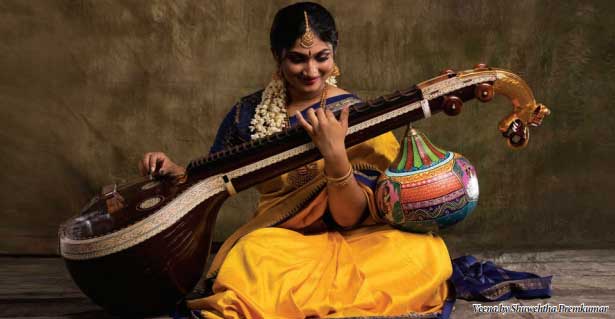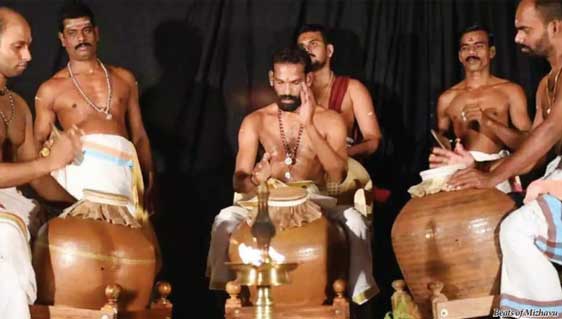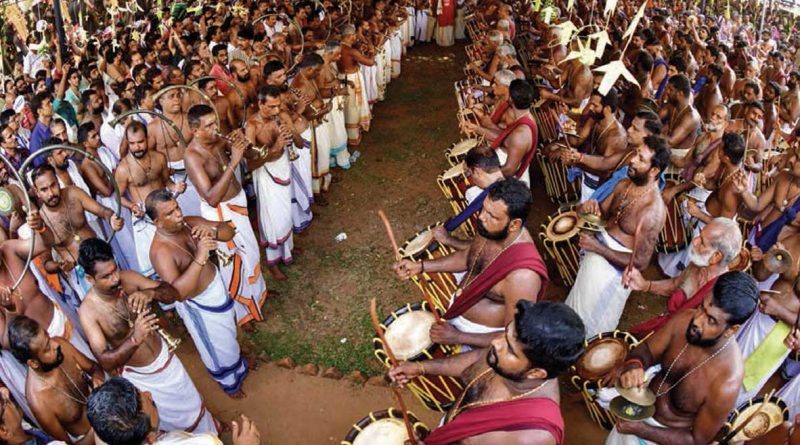Heartbeats of Heritage Kerala’s Musical Instruments

 The term “Kerala music” is associated with a unique, rich musical heritage characterized by traditions observed in temple festivals and distinct musical forms. The music of Kerala prominently features wind instruments like the Odakkuzhal and string instruments like the Veena, either as accompaniment or in their own right. Despite Kerala being the land of wind instruments, a distinct musical tradition centered around the Odakkuzhal has not developed. String instruments like the Nanduni are used primarily as accompaniment for vocal music, and the Kurumkuzhal, capable of producing melodious tunes, is similarly used as an accompanying instrument in traditional ensembles such as Pandi Melam and Panchari Melam. Herein lies the complexity of Kerala’s musical heritage and the instruments it employs. According to musicology, instruments are classified into four categories, as also described in Natyashastra. The first category is the percussion instruments, known as Vitata Vadya or Avanaddha Vadya. These are typically hollow wooden or earthen instruments with one or both ends covered with animal hide, such as the Chenda, Maddalam, and Mizhaavu. Next are the string instruments, categorized as Tata Vadya. Instruments like the Veena and Violin fall under this group. The third category is the wind instruments or Sushira Vadya, including the Odakkuzhal, and the flute used in Nadaswaram. The final category comprises the metal instruments or Ghana Vadya, which produce sound when struck against metal. A distinctive aspect of Kerala’s sonic culture is its emphasis on percussion instruments.
The term “Kerala music” is associated with a unique, rich musical heritage characterized by traditions observed in temple festivals and distinct musical forms. The music of Kerala prominently features wind instruments like the Odakkuzhal and string instruments like the Veena, either as accompaniment or in their own right. Despite Kerala being the land of wind instruments, a distinct musical tradition centered around the Odakkuzhal has not developed. String instruments like the Nanduni are used primarily as accompaniment for vocal music, and the Kurumkuzhal, capable of producing melodious tunes, is similarly used as an accompanying instrument in traditional ensembles such as Pandi Melam and Panchari Melam. Herein lies the complexity of Kerala’s musical heritage and the instruments it employs. According to musicology, instruments are classified into four categories, as also described in Natyashastra. The first category is the percussion instruments, known as Vitata Vadya or Avanaddha Vadya. These are typically hollow wooden or earthen instruments with one or both ends covered with animal hide, such as the Chenda, Maddalam, and Mizhaavu. Next are the string instruments, categorized as Tata Vadya. Instruments like the Veena and Violin fall under this group. The third category is the wind instruments or Sushira Vadya, including the Odakkuzhal, and the flute used in Nadaswaram. The final category comprises the metal instruments or Ghana Vadya, which produce sound when struck against metal. A distinctive aspect of Kerala’s sonic culture is its emphasis on percussion instruments.
These rhythm instruments, used for maintaining tempo, hold much greater prominence and authenticity compared to melodic instruments, which are designed to produce notes and melodies. In both popularity and significance, percussion instruments in Kerala surpass their melodic counterparts. Beyond the well-known percussion instruments like the Chenda and Para, Kerala boasts several lesser-known traditional instruments such as the Uruthudi Virana, Panchamukha Vadyam, and Maram. Kerala is a living museum of percussion instruments, creating unique and grandiose sound sculptures with these instruments, which often overshadow the melodic aspects of our music. Many instruments, which could have evolved as melodic musical instruments, are predominantly used for rhythm. The Kurumkuzhal is a prime example. Though ubiquitous in Kerala, we have not developed a standalone Kurumkuzhal concert. Instead, it is used as an accompanying instrument to enhance the grandeur of the Pandi Melam and Panchari Melam. The Villu is a ubiquitous string instrument, yet our children primarily use it for the Onavillu ritual. Even on the Villu, we have incorporated the rhythmic elements of Thayambaka.
 Another string instrument, the Pulluvan’s Idiyara, is more often used for rhythm than melody. The conventional role of rhythm as an accompaniment to raga has shifted here, with the swara now serving to enrich the rhythm. This underscores the extraordinary significance and authenticity attributed to percussion instruments in Kerala. In Kerala, there are two instruments that exemplify the harmonious blend of melody and rhythm: the Idakka and the Kuzhal. The Idakka, known as “Dakka” in Sanskrit, is mentioned as “Dakka Mridanga” in Harinama Keerthanam. Rather than being purely Keralite, the Mridangam is integral to all of South India. However, the Idakka, a regional variant of the Dakka, is distinctly Keralite. The Idakka, similar in category to the Udukku, has a slender middle with larger ends. It is crafted by stretching cowhide over its frame and tightening it with ropes. Sound is produced by striking it with a thin stick, creating a unique auditory experience. When it comes to sound, experts can even produce the seven musical notes on the Idakka. Many have heard Pallavur Appu Marar play pieces like “Thechimandaram Tulasi” on the Idakka. Additionally, the Idakka serves as an accompanying instrument to music. It is an ancillary instrument for the Ashtapadis sung in Sopana music. Sopana Sangeetham involves singing the Ashtapadis, composed by the poet Jayadeva, in a distinctly Keralite style, accompanied by the distinctly Keralite instrument, the Idakka. Sopana Sangeetham involves singing the Padas composed by Jayadeva. Kathakali Padas also belong to this genre. Irayimman Thampi, a poet and playwright who lived during the 18th and 19th centuries, composed numerous Padas apart from those for Kathakali. His famous Pada, “Prananathan Enikku Nalkiya Paramananda Rasathe,” is well-known.
Another string instrument, the Pulluvan’s Idiyara, is more often used for rhythm than melody. The conventional role of rhythm as an accompaniment to raga has shifted here, with the swara now serving to enrich the rhythm. This underscores the extraordinary significance and authenticity attributed to percussion instruments in Kerala. In Kerala, there are two instruments that exemplify the harmonious blend of melody and rhythm: the Idakka and the Kuzhal. The Idakka, known as “Dakka” in Sanskrit, is mentioned as “Dakka Mridanga” in Harinama Keerthanam. Rather than being purely Keralite, the Mridangam is integral to all of South India. However, the Idakka, a regional variant of the Dakka, is distinctly Keralite. The Idakka, similar in category to the Udukku, has a slender middle with larger ends. It is crafted by stretching cowhide over its frame and tightening it with ropes. Sound is produced by striking it with a thin stick, creating a unique auditory experience. When it comes to sound, experts can even produce the seven musical notes on the Idakka. Many have heard Pallavur Appu Marar play pieces like “Thechimandaram Tulasi” on the Idakka. Additionally, the Idakka serves as an accompanying instrument to music. It is an ancillary instrument for the Ashtapadis sung in Sopana music. Sopana Sangeetham involves singing the Ashtapadis, composed by the poet Jayadeva, in a distinctly Keralite style, accompanied by the distinctly Keralite instrument, the Idakka. Sopana Sangeetham involves singing the Padas composed by Jayadeva. Kathakali Padas also belong to this genre. Irayimman Thampi, a poet and playwright who lived during the 18th and 19th centuries, composed numerous Padas apart from those for Kathakali. His famous Pada, “Prananathan Enikku Nalkiya Paramananda Rasathe,” is well-known.
However, it is unclear what specific instruments were used to accompany these compositions during that era. Kathakali Padas form a vast repertoire, conveying various emotions through different ragas and talas, with a unique style of rendition that has spread throughout Kerala. When these Padas are performed for female characters, the Chenda is not used. Instead, the Chengila and Elathalam are employed for rhythm. However, the singer might face a dilemma: should they sing in tune with the Chenda or the Chengila? Despite being musical, maintaining a fixed pitch is challenging. The instruments on stage must complement not just the music but also the dancer’s movements and expressions. If a grand instrumental flourish suddenly stops, the stage would become still. In Kathakali, the swara and rhythmic elements are not merely accompaniments but the very lifeblood of the performance. Another visual art form where rhythm, music, and dance are seamlessly intertwined is Thullal, created by Kunchan Nambiar. Listening to Thullal songs sung in beautiful ragas is a delight. The charm of Thullal songs lies not only in their melodic variety but also in their distinctive rhythmic patterns, which are both unique and extraordinarily energetic. As the Thullal performer connects this melodic sweetness with the rhythmic patterns, embodying them through dance, the accompanying instruments like the Mridangam and Kuzhithalam provide support.
 In Kerala, these musical instruments too can serve as accompaniments. Their purpose is to complement and enhance the performance. The story goes that Koothu originated from a dispute with the Chakyar. The performance of Koothu employs a heightened language that, while not quite music, transcends ordinary speech. Although the term Koothu means dance, there is minimal dancing involved; it is primarily a vocal performance. The Chakyar’s recitation of verses, presented musically, defines Koothu. This can be considered a unique melodic rendition. The Mizhavu is played either at the completion or midway through the verse, accompanied by the Kudam. This creates a distinctive auditory pleasure, though it is not synchronized with the sloka but follows its recitation, transitioning into storytelling. Koothu originated from the theatre of Koodiyattam. As part of Koodiyattam, there are four days of Koothu, focusing on themes such as Ashanam (feasting), Rajaseva (service to the king), Vinodam (entertainment), and Vanchanam (deception). These performances are carried out by the Vidushaka, who dons the role of the Chakyar in Chakyarkoothu. While characters in Koodiyattam are adorned with elaborate face paintings and headdresses, their dialogues are delivered in a melodious, unique style. The Mizhavu and Kuzhithalam serve as accompaniments, enhancing the performance. Koodiyattam, Kathakali, Vadyamelams, and Panchavadyam are the structured and organized classical arts of Kerala. These forms utilize instruments that can be classified under musical instruments. However, unlike the solo improvisations heard in a Kacheri during Thanivarthanam, these instruments are performed in a manner that stands alone. Moreover, they have achieved prominence, often overshadowing traditional music concerts. In these classical arts, musical instruments primarily serve as accompaniments
In Kerala, these musical instruments too can serve as accompaniments. Their purpose is to complement and enhance the performance. The story goes that Koothu originated from a dispute with the Chakyar. The performance of Koothu employs a heightened language that, while not quite music, transcends ordinary speech. Although the term Koothu means dance, there is minimal dancing involved; it is primarily a vocal performance. The Chakyar’s recitation of verses, presented musically, defines Koothu. This can be considered a unique melodic rendition. The Mizhavu is played either at the completion or midway through the verse, accompanied by the Kudam. This creates a distinctive auditory pleasure, though it is not synchronized with the sloka but follows its recitation, transitioning into storytelling. Koothu originated from the theatre of Koodiyattam. As part of Koodiyattam, there are four days of Koothu, focusing on themes such as Ashanam (feasting), Rajaseva (service to the king), Vinodam (entertainment), and Vanchanam (deception). These performances are carried out by the Vidushaka, who dons the role of the Chakyar in Chakyarkoothu. While characters in Koodiyattam are adorned with elaborate face paintings and headdresses, their dialogues are delivered in a melodious, unique style. The Mizhavu and Kuzhithalam serve as accompaniments, enhancing the performance. Koodiyattam, Kathakali, Vadyamelams, and Panchavadyam are the structured and organized classical arts of Kerala. These forms utilize instruments that can be classified under musical instruments. However, unlike the solo improvisations heard in a Kacheri during Thanivarthanam, these instruments are performed in a manner that stands alone. Moreover, they have achieved prominence, often overshadowing traditional music concerts. In these classical arts, musical instruments primarily serve as accompaniments


